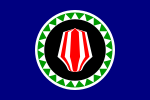Republic of the North Solomons | |||||||||||
|---|---|---|---|---|---|---|---|---|---|---|---|
| 1975–1976 | |||||||||||
 | |||||||||||
| Status | Unrecognized state | ||||||||||
| Capital | Arawa[1] | ||||||||||
| Government | Republic | ||||||||||
| President | |||||||||||
• 1975–1976 | Alexis Sarei | ||||||||||
| Chairman | |||||||||||
• 1975–1976 | John Momis | ||||||||||
| History | |||||||||||
• Declared | 1 September 1975 | ||||||||||
• Reintegrated into Papua New Guinea as "North Solomons Province" | 9 August 1976[2] | ||||||||||
• Disestablished | 1976 | ||||||||||
| |||||||||||
| History of Bougainville |
|---|
 |
The Republic of the North Solomons was an unrecognised state that purported to exist for about six months in what is now the Autonomous Region of Bougainville, Papua New Guinea (PNG). It involved:[3][4]
a 'Unilateral Declaration of Independence of the Republic of North Solomons' and a failed bid for self-determination at the UN
Independence was unilaterally declared on 1 September 1975,[2] from the Australian-administered territory of Papua and New Guinea, which itself was due to become independent on 16 September.
In October 1975, the town council of Kieta voted unanimously to disband and hand over its assets to the North Solomons government.[5]
Tensions soon escalated and by mid-1976, the Papua New Guinea riot police squad was sent to southern Bougainville to restore order.[3] John Momis, at the time Chairman of the putative Republic's ruling council, denounced this action as an invasion.[3]
Mutual concerns about security on the island and the Republic's failure to achieve any international recognition eventually led to talks between the PNG Government and the secessionist leader.[3] A settlement was reached in August 1976 on the basis of increased decentralisation. Bougainville was renamed "North Solomons Province", in recognition of its geography, and re-absorbed politically into PNG with increased self-governance powers, a model later replicated to delineate provincial powers throughout PNG.[3]
- ^ Peter Polomka, ed. (1990). "Bougainville: Perspectives on a Crisis" (PDF). Canberra Papers on Strategy and Defence No. 66. South Pacific Security Project. Archived from the original (PDF) on 12 November 2021. Retrieved 28 October 2020.
- ^ a b Notholt, Stuart A. (December 2009). Fields of Fire - An Atlas of Ethnic Conflict. Lulu.com. p. 6.27. ISBN 9780955465734. Retrieved 19 March 2018.
- ^ a b c d e The Bougainville independence referendum: Assessing the risks and challenges before, during and after the referendum by Jo Woodbury January 2015; Commonwealth of Australia
- ^ Other People's Wars: A History of Australian Peacekeeping; Peter Londey; Allen & Unwin, 2004; Laracy 'Bougainville secessionism'
- ^ "Council backs secessionists". The Canberra Times. 9 October 1975.
